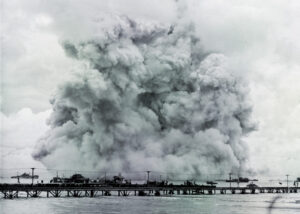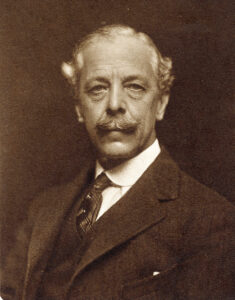DIVIDED WATERS
Divided Waters by Ivan Musicant, a naval historian who has published books on various types of warships, is a general history of the naval side of the Civil War. It is not, however, the “first naval history of the Civil War to appear in more than twenty-five years,” as the publisher’s marketing blurbs imply. William M. Fowlers’ Under Two Flags: The American Navy in the Civil War was published in 1990.
Musicant is at his best when describing battles and personalities. His accounts of the Alabama-Kearsarge engagement and the Battle of Mobile Bay are particularly graphic, and his characterizations of naval leaders are quite good. He clearly prefers firsthand accounts, quoting extensively from contemporary diaries and letters as well as published memoirs. He has a knack that is characteristic of good writers for weaving in fascinating anecdotes and incidental information on individuals, ships, and activities without interrupting the narrative. The result is a most readable book.
But is it a good book? A good history book should reveal newly discovered information, suggest a new interpretation of previously published material, or make up for an absence of the first two qualifications with substantial literary merit, as Carl Sandburg did in his biography of Lincoln. Unfortunately, Divided Waters does none of the above.
Musicant’s bibliography is inadequate. It is to a great degree a regurgitation of sources used by others writing on the same subject. For a general survey, which Divided Waters is, the incorporation of primary sources is not an absolute requirement, but an examination of all relevant published works on the topic is. In this the author has been inexcusably negligent, apparently examining nothing published since 1989.
What about new interpretations of the topic? In 1962 Bern Anderson’s By Sea and by River: The Naval History of the Civil War was published. The book’s major thesis was that the Union blockade was one of the major factors in the Confederacy’s defeat, and that therefore the Confederate navy’s main objective was the defeat of this blockade. In Divided Waters Musicant writes, “It was the unflinching naval blockade that slowly strangled the Confederacy….” Later he writes, “Stephen Mallory’s strategy for conducting the Confederate naval war was based almost wholly on defeating the Union blockade.” In these statements the author has ignored the scholarship of the past 30 years: historians have convincingly challenged the success of the blockade.
Musicant makes the same mistake that Anderson made many years ago in belittling the Confederate navy. The Confederates placed in operation at one time or another more than 130 warships. Of this number approximately 25 were ironclads, not all “floating batteries,” as he states, but rams as well. Although the ironclads did break down frequently (as did Union blockade vessels), they performed adequately in defense. He also understates the Confederates’ accomplishments in naval construction. Despite problems in transporting raw materials to manufacturing facilities and a shortage of labor, their success was impressive.
I challenge the author’s assertion that by the end of the war, the U.S. Navy had become “arguably the most powerful sea force in the world with a total of 670 ships.” The number is impressive, but most of the ships were conversions from merchant ships, steamboats, ferries, etc. The ironclads were notoriously unseaworthy and often had to be towed. No American ships could compete with Great Britain’s powerful armorclads.
There is a need for a general naval history of the Civil War incorporating the most recent scholarship, but Divided Waters is not it.
William N. Still, Jr.




